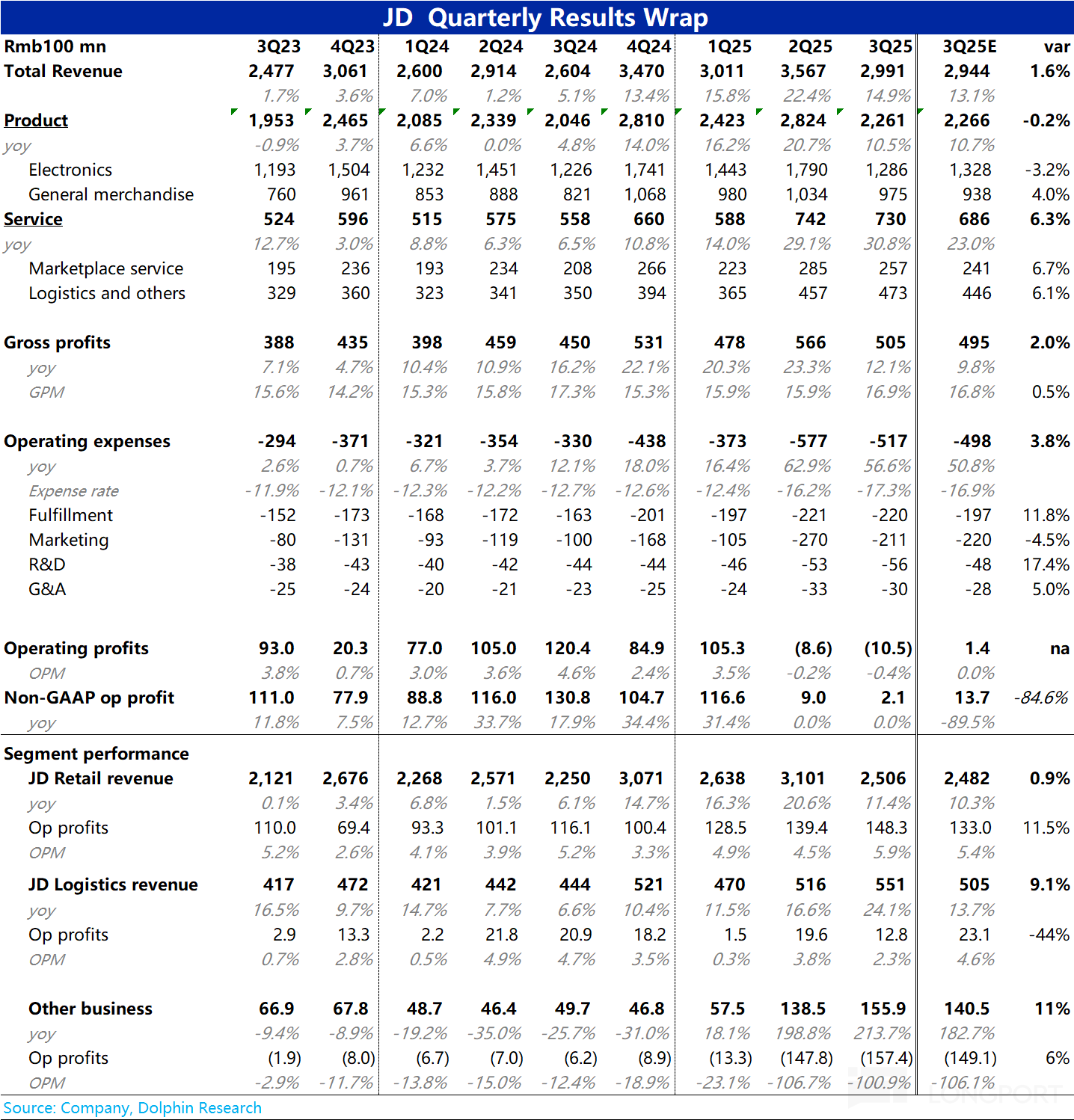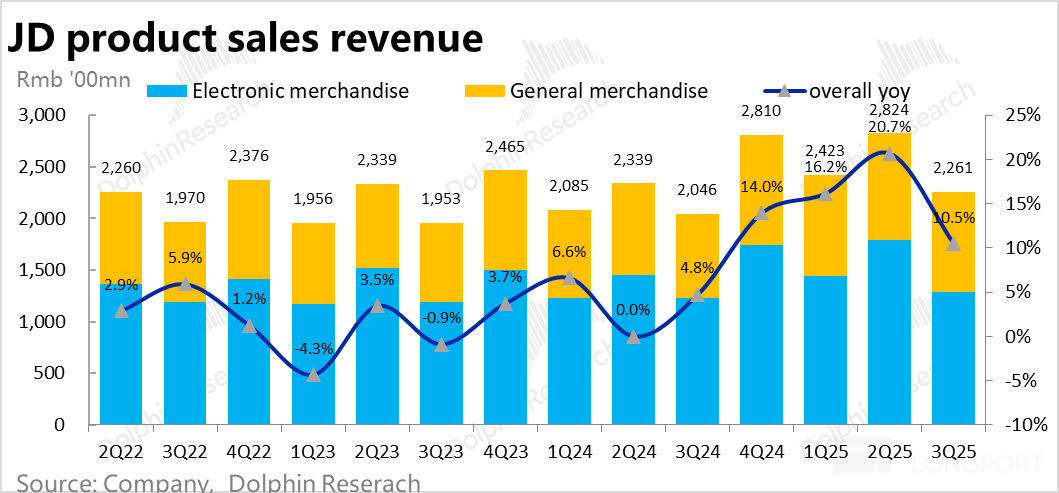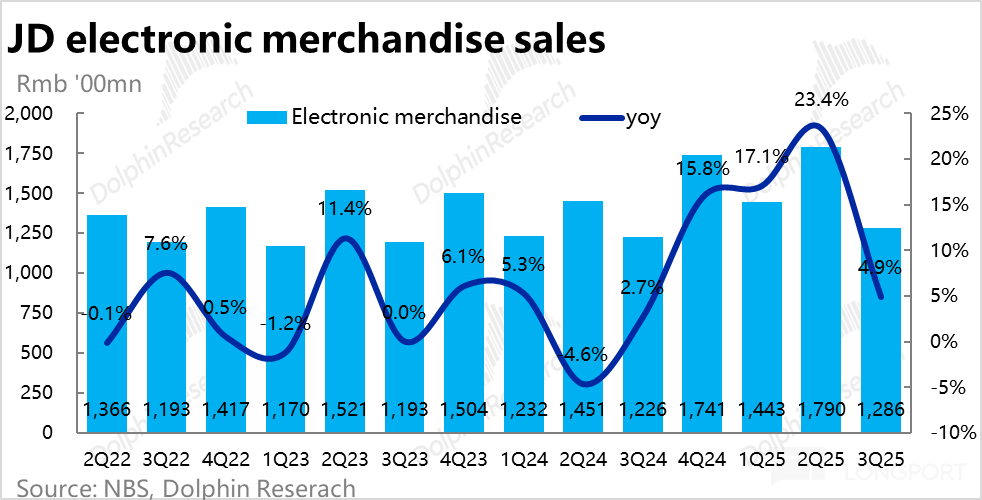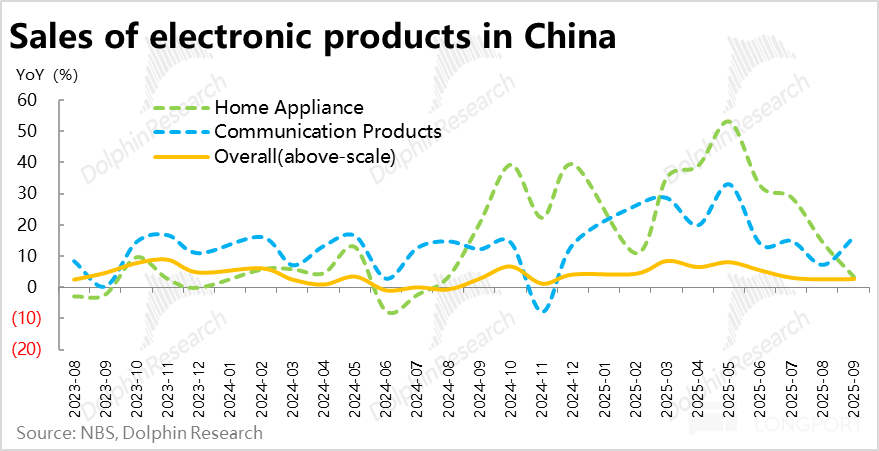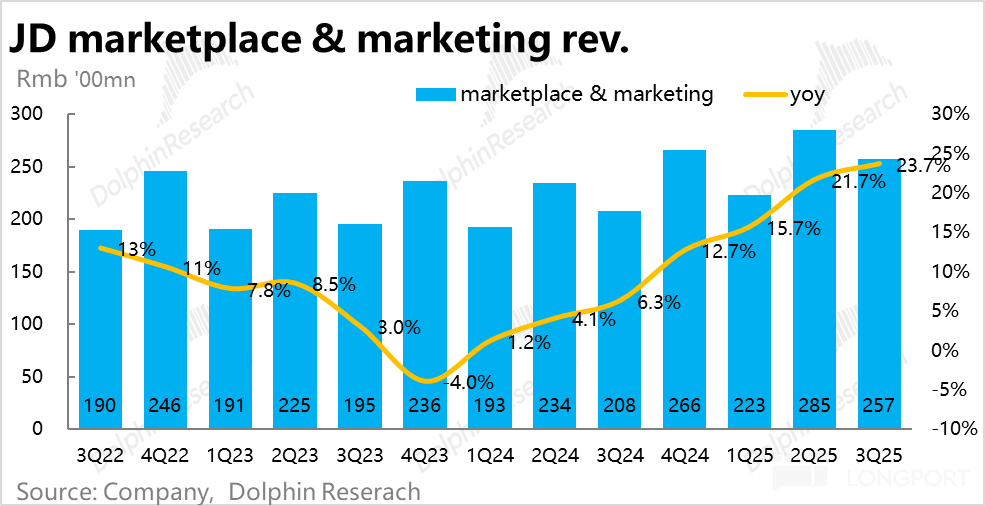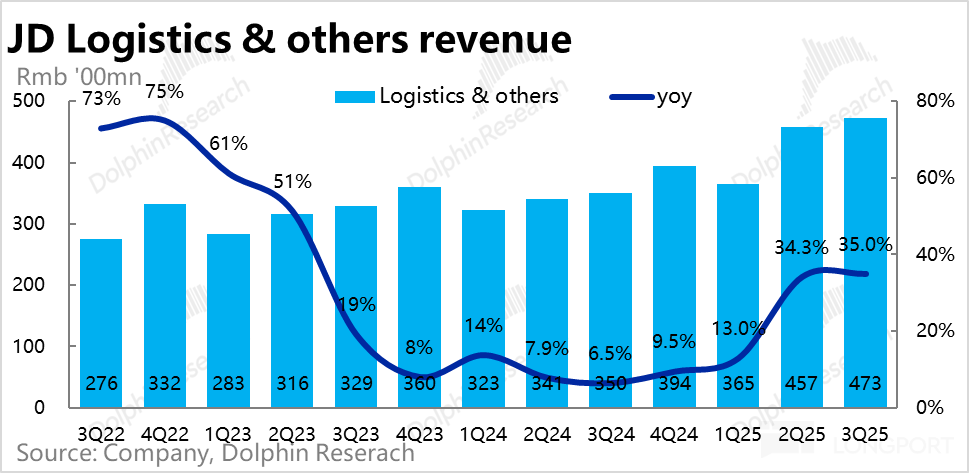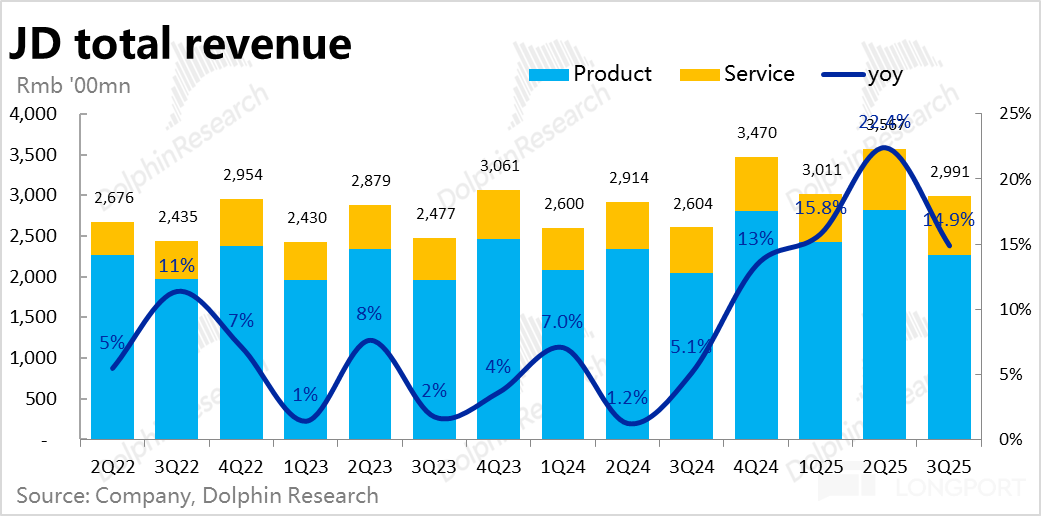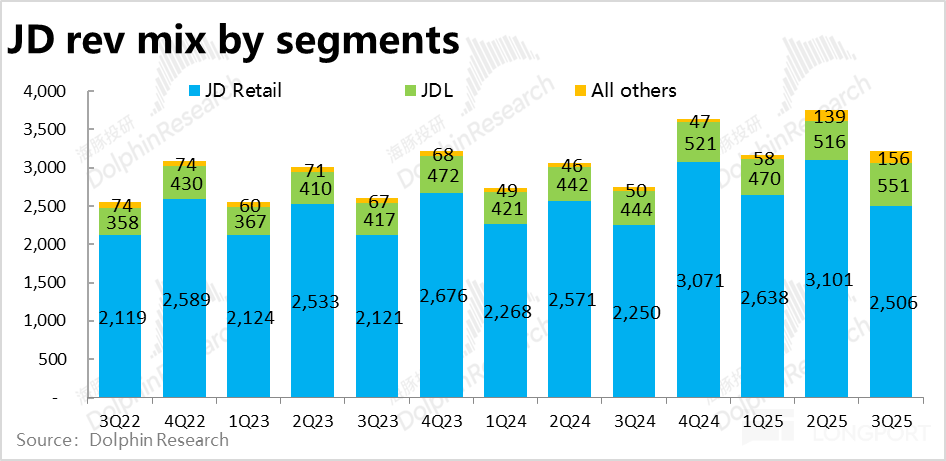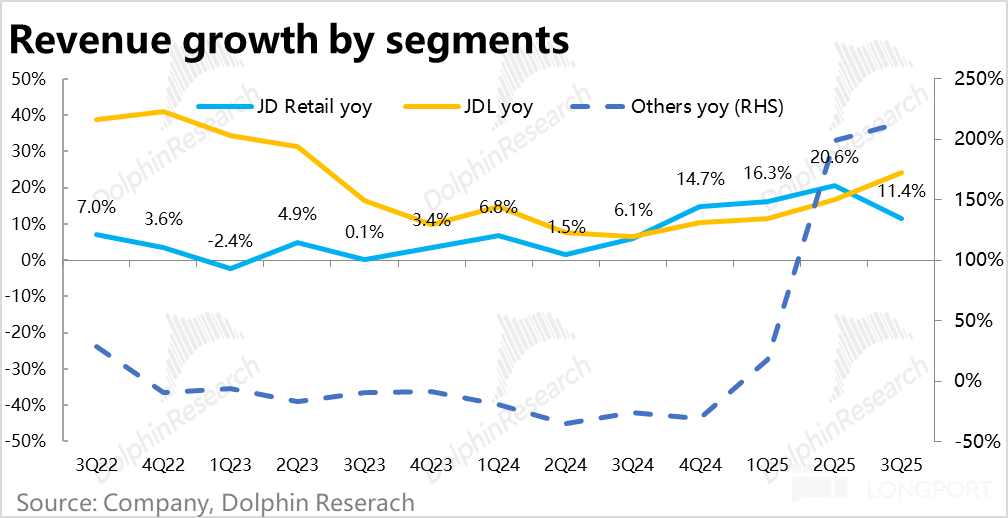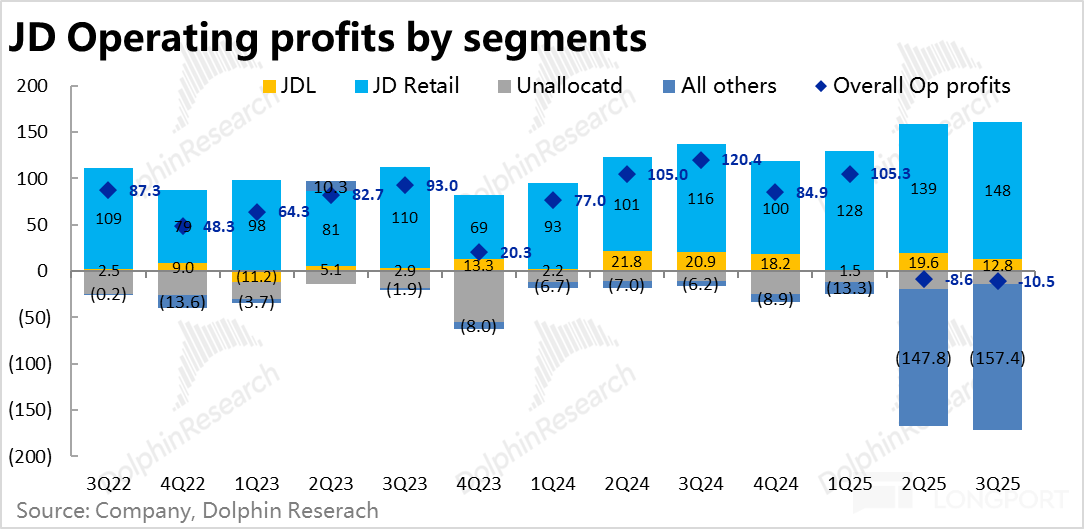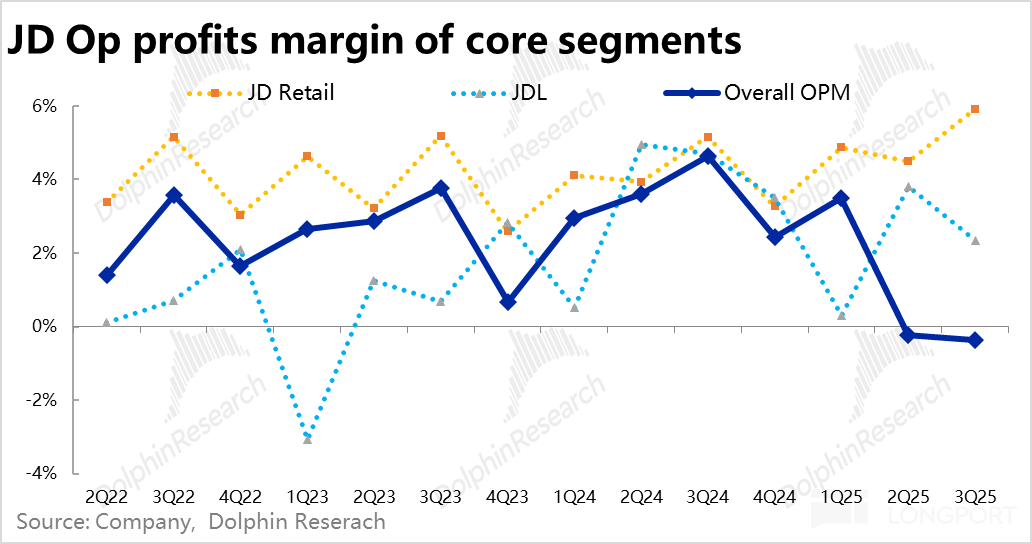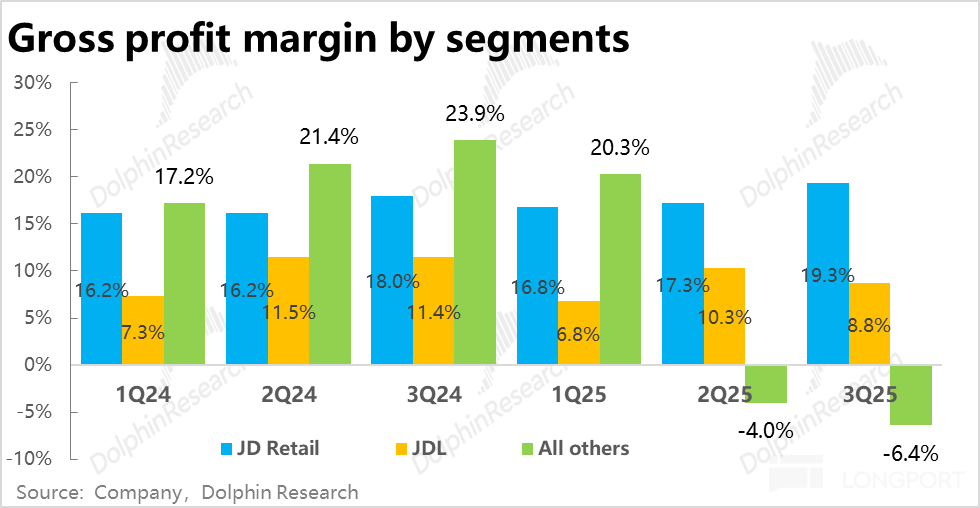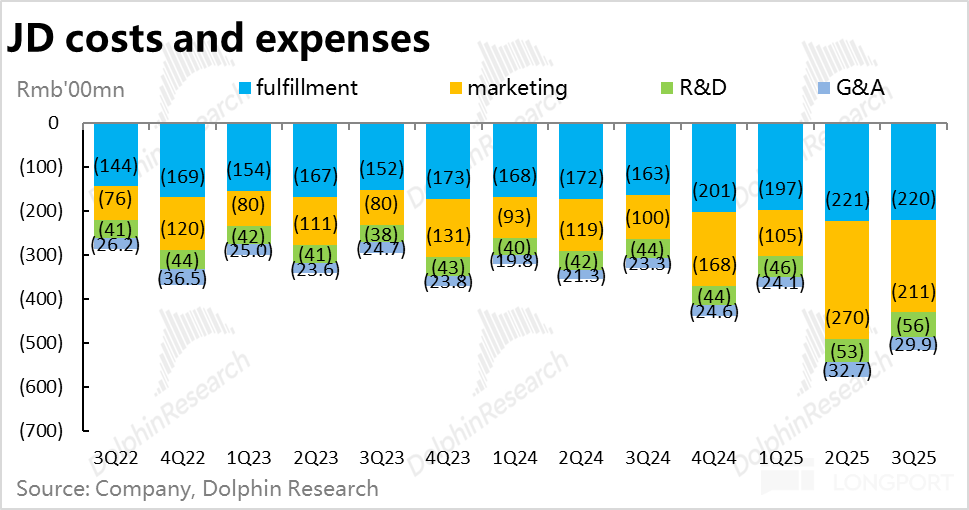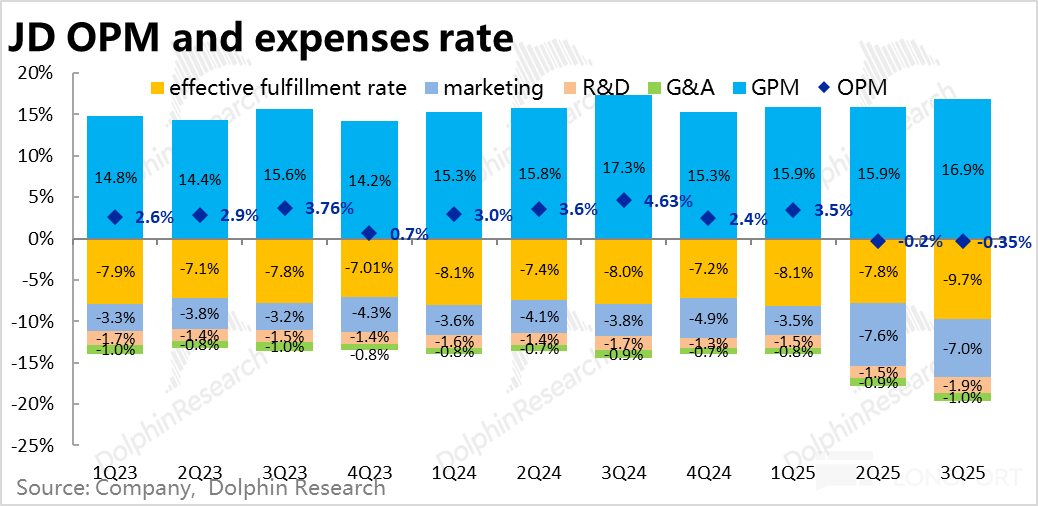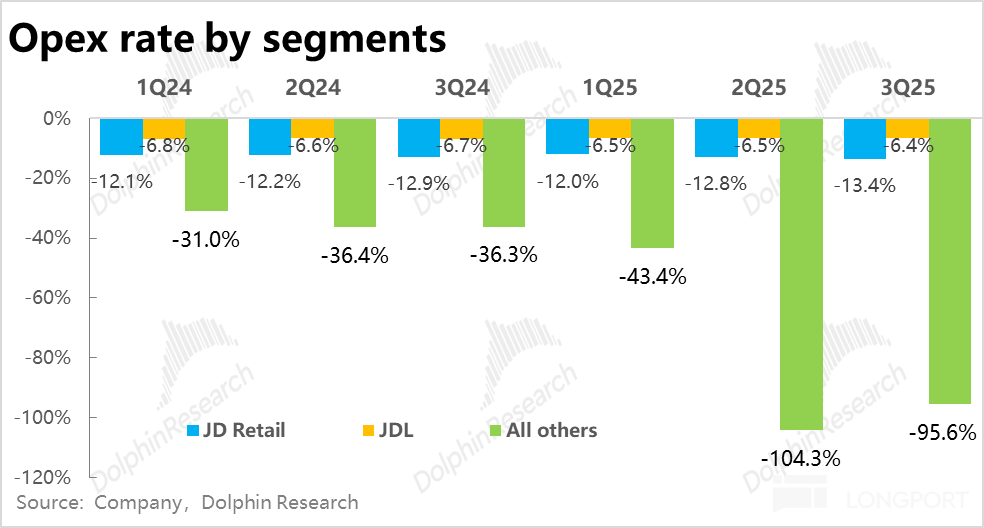
JD.com: Even without state subsidies, still needs to 'strike everywhere'

China's three major e-commerce giants--$JD.com(JD.US) first delivered their Q3 financial report on November 13. In summary, this quarter's performance was also "fragmented," with both good and bad news. Overall, revenue remained stable, but losses were more severe than expected. By segment, the core mall segment performed excellently, with both revenue and profit being superior, while the profits of new businesses and JD Logistics were worse than expected. Detailed points are as follows:
1. Revenue is okay, but profit is not: In terms of overall figures, JD.com's total revenue for the quarter increased by 15% year-on-year, slightly higher than the market expectation of 13%. Although the growth rate of electrical sales has indeed deteriorated significantly, the growth of other businesses is quite good.
In terms of profit, the group's overall GAAP operating loss was 1.05 billion, with the loss margin slightly increasing quarter-on-quarter, and worse than market expectations. Although the mall business profit exceeded expectations, it was dragged down by poor profits from logistics and new businesses. After adding back stock-based compensation and amortization, the adjusted operating profit was a positive 210 million, also below expectations.
2. Despite the decline in state subsidies, self-operated retail is not bad: Due to the decline in state subsidies and entering a high base period, the revenue growth rate of electrical products sharply fell to 5%, worse than the market's conservative expectations. This can be seen from the sales growth rate of home appliances announced by the statistics bureau, which was only 2.7% by September.
However, driven by supermarkets and apparel categories, general merchandise grew by nearly 19% year-on-year, with the growth rate increasing by 2.4 percentage points quarter-on-quarter, significantly better than market expectations. With the offsetting of electrical goods and general goods, JD.com's overall self-operated retail revenue grew by 10.5% this quarter, roughly in line with expectations. Of course, the trend of significant slowdown in growth is still evident.
3. Stronger growth in services and logistics: Compared to the relatively stable retail business, the commission and advertising revenue growth rate for 3P sellers reached nearly 24%, rising by 2 percentage points quarter-on-quarter. It is evident that JD.com's 3P merchant ecosystem and monetization capabilities are continuously optimizing.
Meanwhile, logistics revenue also grew by 35% this quarter, with the growth rate roughly flat quarter-on-quarter. In addition to the incremental delivery brought by food delivery, combined with JD Logistics' own announcements, it mainly benefited from incremental fulfillment demand from internal and overseas business.
4. Good mall profits can't offset the "bottomless pit" of new businesses: Core business--JD Mall's operating profit this quarter was 13.9 billion, growing nearly 28% year-on-year, exceeding market expectations by a full 1.5 billion, which is quite good. The operating profit margin increased significantly by 0.7 percentage points year-on-year, and the increase compared to last quarter further expanded, showing that the trend of profit improvement in the mall business was not affected by the decline in state subsidies.
New business losses reached 15.7 billion this quarter, increasing by about 1 billion quarter-on-quarter. Since the company clearly stated that investment in food delivery was reduced this quarter, the expansion of losses was due to increased investment in JD Joy and overseas business.
Additionally, JD Logistics' operating profit this quarter was also significantly below expectations, about 1 billion less than expected, not only due to more investment in domestic and overseas fulfillment equipment, but also possibly because it partially bore the losses from food delivery business.
5. Looking at costs and expenses to understand why profit margins deteriorated: This quarter, the group's overall gross margin was 16.9%, down about 0.4 percentage points year-on-year, marking the first decline since Q1 2022, which is the first layer of reason for profit deterioration. Among them, the main site's gross margin actually continued to improve, increasing by 1.3 percentage points year-on-year; JD Logistics and new businesses' gross margins both deteriorated year-on-year.
On the expense side, overall operating expenses this quarter totaled 51.7 billion, continuing to grow by 57% year-on-year, but the growth rate and year-on-year net increase both declined compared to last quarter.
Among them, marketing expenses growth narrowed significantly, with a year-on-year net increase of about 11.1 billion this quarter, compared to a net increase of 15.2 billion last quarter, significantly reduced, suggesting that food delivery subsidies indeed decreased significantly. Meanwhile, R&D expenses and fulfillment expenses grew faster compared to last quarter, which should be due to increased investment in overseas and other businesses.
By segment, the mall business's expense rate is still increasing, but the increase is smaller than the increase in gross margin. Meanwhile, new business expenses this quarter were 14.9 billion, spending 0.5 billion more quarter-on-quarter, the expansion of new business losses was due to changes in revenue structure (gross margin decline) and increased expenses.

Dolphin Research's View:
Overall, Dolphin believes the two core signals conveyed by JD.com's performance this time are:
1) Although with the decline in state subsidies, JD.com's sales of electrical goods are indeed rapidly deteriorating, and more severe than expected. But the good news is--JD.com's growth is not as dependent on the diversion of electrical goods as the market fears. Even if the growth rate of electrical goods slows significantly, whether it is general merchandise, 3P services, or logistics business, they still have the ability to achieve independent growth within their respective development tracks.
2) The bad news is, although after Alibaba's entry, JD.com can also wisely withdraw from the positive competition for market share at any cost, narrowing the losses generated by the food delivery business quarter-on-quarter. But JD.com has not stopped fully attacking multiple businesses, leading to continued deterioration of profits outside the mall segment.
Specifically, besides picking up the "JD Joy" brand again and trying to expand coverage of white-label products and corresponding cost-effective consumers. Recently, JD.com's actions in overseas business can be described as aggressive.
Including: 1) Reintegrating and launching the JoyBuy business, with a localized operation approach, aiming to expand into major European markets such as the UK, Germany, and France; 2) Acquiring European local electronic retail companies (MediaMarkt and Saturn's parent company), which have over 1,000 offline stores, for a consideration of 2.2 billion euros; 3) Spending about 4 billion HKD to acquire Hong Kong local supermarket "Kaibo".
Although Dolphin does not intend to assert that JD.com's investments in these overseas businesses will fail, domestic companies operating overseas local (especially physical store) retail businesses do not have much successful historical experience. Regardless of future incremental revenue and profit, the initial investment in stores, warehousing, logistics, etc., will inevitably drag down the group's profitability.
3) Although it may no longer be crucial for JD.com, it still has considerable reference value--this quarter, with reduced total investment and losses, JD.com's food delivery GMV still grew by over 10% quarter-on-quarter, and both pricing structure and UE model are improving (subsidies decreased while the proportion of high-ticket main meals increased). Management also clearly stated in the conference call that the goal of JD Food Delivery/Flash Purchase is self-sufficiency, but also mentioned that the current breakeven daily order volume for food delivery will be higher than the previous 20 million orders.
4) What is reassuring is that JD Mall, besides maintaining stable growth, is also continuing to improve in terms of profit. As we emphasized last quarter, as long as the core business does not encounter problems, JD.com has the option to "turn back." After all, the company has the right to choose to abandon new businesses, and the resulting loss problem can be resolved.
In terms of outlook and judgment, as JD Food Delivery gradually loses "volume," the market's focus on JD.com is no longer overly concentrated on the food delivery business (of course, there is still concern about the overall losses of new businesses), gradually returning to the growth momentum of its core mall business.
In this regard, we can see: with the decline in state subsidies and the high base period, the slowdown in growth of JD.com's core retail or mall business is still inevitable. Although with the offsetting of other businesses, even without the benefit of state subsidies, JD.com may not be as bad as feared. But the growth rate of the mall segment has still fallen from around 15-20% in previous quarters to around 10% now--meaning JD.com can no longer clearly lead the industry growth rate or competitors, nor can it continue to be as good.
In other words, since the core business of the basic plate still maintains a stable stance, Dolphin believes JD.com's valuation will have support. But at the same time, as the dividend window period gradually ends, whether from the company's own ability to bear expenses, or from the market's patience with the company "spending money everywhere," aggressive investments leading to continued expansion of losses outside the mall segment will undoubtedly become increasingly unacceptable.
Although in the conference call, the company stated that it would be cautious about investments. Dolphin believes that attention should still be paid to when new business losses can turn downward, using this key signal as a criterion.
In terms of valuation, since this year's profit is basically not a reference value, and adjusted net profit contains too many non-operating factors, we use the profit of the core main site in 2026 as the main benchmark. Assuming the main site's operating profit in 2026 continues to grow by 10% compared to 2025, it would be about 63 billion. The rest depends on how much the annual combined loss of new business + logistics will be, assuming it is 30 billion, then the group's overall operating profit for the year would be about 33 billion. Considering that other non-revenue factors such as interest can roughly offset tax expenses, tax expenses will not be deducted. Then the company's market value of about 313 billion corresponds to approximately 9.5x PE.
For long-term investors, it is still a valuation that is not considered high.
Detailed interpretation of this quarter's financial report:
I. Overall revenue is not bad, is JD.com not so reliant on electrical products?
1. The largest self-operated retail business, revenue this quarter was 226.1 billion, with a significant slowdown in year-on-year growth to 10.5%, from the trend, it is clearly visible that after the decline in state subsidies, JD.com's self-operated retail clearly outperforming the industry's "good days" have come to an end. However, from the perspective of expectation difference, due to the impressive growth of general merchandise offsetting the decline in electrical sales growth, the overall retail growth rate was only slightly lower than the sell-side expectation by 0.2%, which is not considered an unexpected negative signal.


Specifically, the revenue growth rate of electrical products this quarter was only 5%, although the market had anticipated that growth would significantly decline under the influence of the decline in state subsidies and last year's high base, the actual situation was still worse. According to data released by the statistics bureau, the sales growth rate of home appliances above designated size has continued to plunge since the high point in May, reaching only 2.7% by September. It can be seen that the overall sales deterioration speed and degree of electrical categories after the decline in state subsidies are quite severe.
However, driven by supermarkets and apparel categories (JD has opened multiple offline malls, according to disclosures, the number of JD Mall stores has exceeded 20, and the number of JD Home Appliance flagship stores has also exceeded 100; in September, the company launched the "JD Fashion" label, providing selected high-quality apparel products), general merchandise grew by nearly 19% year-on-year, with the growth rate increasing by 2.4 percentage points quarter-on-quarter, also significantly better than market expectations. Even though the market had generally expected good sales of general merchandise before the performance, the actual situation was even better.
Therefore, with the offsetting of electrical and general goods, JD.com's self-operated retail growth this quarter ultimately fell roughly within expectations.



2. Platform & Logistics are also good: With self-operated retail roughly meeting expectations, the commission and advertising revenue growth rate for 3P sellers also rose by 2 percentage points quarter-on-quarter to nearly 24%, showing strong performance. This suggests that JD.com's 3P merchant ecosystem and monetization capabilities are also continuously optimizing.
Including JD Logistics, Dada Express, and food delivery business (as of Q3, food delivery mainly still contributes delivery revenue, with less commission revenue), logistics revenue also maintained a high growth rate of 35% year-on-year. In addition to the incremental delivery revenue contributed by food delivery, combined with JD Logistics' own performance announcements, it mainly benefited from good growth in supply chain and overseas business.


Overall, with electrical and general merchandise sales roughly balancing each other, while advertising and logistics business grew strongly, JD Group's overall revenue grew nearly 15% year-on-year this quarter, although the growth rate slowed quarter-on-quarter, slightly outperforming the sell-side expectation of 13%. From this, Dolphin believes a possible positive signal revealed is--JD.com's growth is not as dependent on the diversion of electrical goods as the market fears. Even if the growth of electrical goods drops significantly due to the decline in state subsidies, whether it is general merchandise, 3P services, or logistics, they are currently able to achieve independent growth within their respective development tracks.

II. Impressive mall profits can't compete with the widening losses of new businesses
By business segment:
1) Core segment--JD Mall's revenue grew 11.4% year-on-year. Although the 3P business growth significantly exceeded expectations, its revenue share is only slightly over 10% (due to caliber issues), so its direct impact on growth is still limited.
2) JD Logistics (JDL) revenue grew 24% year-on-year this quarter, but mainly driven by internal revenue from JD Group, making the revenue appear somewhat inflated. The significant increase in internal revenue offset this quarter can verify this situation.
3) Including food delivery business, the new business segment, revenue this quarter was 15.6 billion, growing 12.6% quarter-on-quarter, slightly exceeding market expectations. In the case of reduced investment in JD's food delivery business this quarter (food delivery revenue may not necessarily decline quarter-on-quarter, but at least will not grow significantly), JD's revenue growth in other new businesses outside of food delivery matches the increased investment in these businesses.


In terms of profit, the group's overall GAAP operating loss was still 1.05 billion this quarter, with the loss margin slightly increasing quarter-on-quarter, and worse than market expectations. Similar to last quarter, the mall business profit was good, but logistics and innovative business profits were dragged down by poor performance. After adding back stock-based compensation and amortization, the adjusted operating profit was a positive 210 million, also declining quarter-on-quarter, and below expectations.
By business segment:
1) JD Mall's operating profit was 13.9 billion, growing nearly 28% year-on-year, exceeding market expectations by a full 1.5 billion, still performing well. Mainly because the mall segment's operating profit margin increased significantly by 0.7 percentage points year-on-year, the increase was further expanded compared to last quarter's 0.6 percentage points, accelerating the release of segment profits.
2) JD Logistics' operating profit this quarter was also significantly below expectations, only 1.28 billion, significantly reduced quarter-on-quarter, about 1 billion lower than expected. Combined with the aforementioned JD Logistics confirming a large amount of internal revenue from JD Group this quarter, Dolphin speculates it may be because JD Logistics took on part of the food delivery function, thus taking on at least part of the additional revenue and losses brought by the food delivery business.
3) New business losses reached 15.7 billion this quarter, further increasing by about 1 billion quarter-on-quarter. Since the company clearly stated that investment in food delivery was reduced this quarter, it can be inferred that food delivery losses also decreased quarter-on-quarter, so the new business's additional losses should mainly be due to increased investment in JD Joy and overseas business.


III. New business blooms everywhere, dragging down the group's gross margin and expense ratio
From the perspective of costs and expenses, the reasons for continued deterioration in profit margins. First, the group's overall gross margin this quarter was 16.9%, down about 0.4 percentage points year-on-year, marking JD Group's first gross margin decline since Q1 2022. This led to gross profit growing by about 12% year-on-year to 50.5 billion, lower than the revenue growth rate. This is the first layer of reason for profit margin deterioration.
By segment, the main site's gross margin continued to improve, increasing by 1.3 percentage points year-on-year, and the increase was further expanded quarter-on-quarter compared to last quarter. It can be seen that with the optimization of revenue structure and improvements in goods procurement, the main site's profit margin improvement trend was not affected by the decline in state subsidies.
Meanwhile, JD Logistics and new businesses' gross margins both deteriorated year-on-year, mainly due to the impact of investment in food delivery and other businesses.
Overall, due to the decline in gross margins of logistics and new businesses, while the revenue share of these two segments increased (from last year's 13.6% to 16.2%), it led to the group's overall gross margin decline.


On the expense side, overall operating expenses this quarter totaled 51.7 billion, growing by 57% year-on-year, but the year-on-year growth rate and net increase both declined compared to last quarter.
Among them, by expense type, marketing expenses growth narrowed significantly, with a year-on-year net increase of about 11.1 billion this quarter, compared to a net increase of 15.2 billion last quarter, significantly reduced, suggesting that food delivery subsidies indeed decreased significantly.
Meanwhile, R&D expenses and fulfillment expenses grew faster compared to last quarter, which should be due to increased investment in overseas and other businesses.
By segment, 1) JD Mall's operating expenses grew 16% year-on-year, higher than the revenue growth rate. But the expense rate still expanded year-on-year, but the expansion rate narrowed.
2) Meanwhile, the logistics segment's expense rate actually narrowed from both year-on-year and quarter-on-quarter perspectives, so JD Logistics' profit margin decline was entirely due to the revenue structure leading to a decline in gross margin.
3) New business expenses this quarter were 14.9 billion, spending 0.5 billion more quarter-on-quarter, so the expansion of new business losses was due to changes in revenue structure (gross margin decline) and increased expenses.



<End of text>
Past Dolphin Research on [JD.com]:
Financial Report Analysis
May 13, 2025 Commentary"State Subsidies" Support, Can JD.com Hold Its Head High Again?
May 13, 2025 MinutesJD.com (Minutes): Food Delivery UE Still Difficult to Assess, Repurchase Average Price $37
March 6, 2025 Commentary"State Subsidies" Support, JD.com Finally "Out of the Pit"
March 6, 2025 MinutesJD.com (Minutes): Electrical Growth High Before Low After, General Merchandise Strong All Year
November 14, 2024 CommentaryJD.com: State Subsidies Expected to Continue Until Next Year (3Q24 Conference Call Minutes)
November 14, 2024 MinutesRevived by "State Subsidies," Is JD.com Going to "Resurrect"?
August 16, 2024 Financial Report CommentaryJD.com "Counterattack"? Think Again!
August 16, 2024 MinutesJD.com: Can the Unexpected Profit Continue? How Will the Competitive Landscape Change?
May 16, 2024 Financial Report CommentaryWithout Repurchase, Is JD.com Still Worth It?
May 16, 2024 Conference CallJD.com: Continue to Focus on FMGC and 3P Ecosystem
March 6, 2024 Conference CallJD.com: Mid to High Single-Digit Growth in 24, Ensure Profit Does Not Decline Year-on-Year
March 6, 2024 Financial Report CommentaryJD.com: As Long as Dividends and Repurchases Are Plenty, Even Poor Students Can Manage
In-depth
June 18, 2025JD.com "Betting Big" on Food Delivery: Desperate Measures or Carefully Crafted Strategy?
June 19, 2025JD.com, Alibaba, Meituan All Enter the Fray, Is Food Delivery the Final Battle of E-commerce?
April 14, 2023Bone Surgery, Does JD.com on the "Operating Table" Still Have Value?
April 22, 2022Meituan, JD.com, Why Are They Outstanding in the Battle for Stock?
Risk Disclosure and Statement of This Article:Dolphin Research Disclaimer and General Disclosure
The copyright of this article belongs to the original author/organization.
The views expressed herein are solely those of the author and do not reflect the stance of the platform. The content is intended for investment reference purposes only and shall not be considered as investment advice. Please contact us if you have any questions or suggestions regarding the content services provided by the platform.


